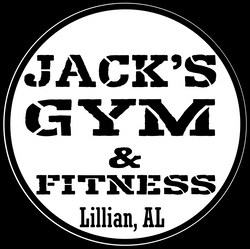Gym language is a language all of its own. Whether you are new to the gym or need to add some gym language to your repertoire, this blog may help you to talk gym like a pro! Of course, wearing a JACK'S GYM t-shirt make you look like a gym pro...even if you are mute! So let's get started. The best way to start learning gym speak is chronologically. What happens first when you arrive at the gym?
WHATCHA TRAINING TODAY?
After saying hello to your gym friend or friends, the next question out of someone's mouth inevitably is, "Whatcha training today?" This is not the time for a huge dissertation, "Well...thank you for asking..." STOP! It's one word for a single body part, LEGS, CHEST, BACK...and so on, or multiple words for multiple body parts, CHEST and TRICEPS or CHEST, SHOULDERS, and TRICEPS; BACK and BICEPS...and so on. You may also describe your training day as "full body" or "upper body" or "lower body" type splits. One additional ways to say everything in clear and concise verbiage is simply "push day" or "pull day" or "leg day." Spout out push, pull, or legs and every salty gym rat will know whatcha training today!
WHATCHA DOING FOR CHEST?
A follow up question from someone training the same body part or parts may be, "Whatcha doing for...?" In our title, we have pointed out chest for one particular reason: everyone is always training chest! It's called INTERNATIONAL CHEST DAY for a reason! From an insider's perspective, this is were you can attract (or get rid off) a potential workout partner. Whatcha doing for chest is the running order of events for the chest workout. Keep it brief but descriptive.
- Bench press
- Dumbbell incline press
- Dumbbell flyes
- Machine press
- Pec deck machine
Someone: WOW, that's what I was going to do
You: We can train together. (Only say this if you want to train together! If you don't want to train with someone, now is the time to say, "I like working out by myself...so I don't get distracted with talking.)
Someone: COOL! Let's get started or I completely understand, but I don't like to talk during my workout because I have a limited amount of time to get everything completed.
You: Umm... and make a decision
Having a workout partner sometimes is the boost you need to make progress. A training partner can be there to spot you during your set or just provide needed motivation!
WHATCHA SETS AND REPS LOOK LIKE?
This is the blueprint of your training session. Here is where your training modality will produce the next IFBB pro or not. For most of us, this where the satisfaction of going to the gym is measured through our efforts.
SETS
SETS fall into several categories. SETS are either warm-up sets, bridge sets, feel sets, working sets, top/heaviest sets, straight sets, or drop sets. There may be a few other descriptors for SETS, but categorically, these descriptions should suffice.
Warm-up sets are just that- they warm-up the body and muscle groups to be trained. Bridge sets are the sets that connect the warm-up sets to the top/heaviest sets. Feel sets are like bridge sets. Termed "feel sets" by Mr. Olympia Jay Cutler, the idea to feel the muscles in action to create the mind/muscle connection.
Working sets are the set that make up the bulk of the exercise. Not the warm-up set or the top/heaviest sets, but everything in the middle, like an Oreo cookie! Drop sets are used to extend an exercise. A lifter can go no farther by adding weight to the load, so the load is lightened to extend the lifting experience of that movement.
REPS
REPS on the other hand describe what is happening in both duration and intensity during the SET. A warm-up set of 15, a feel set of 12, a top/heaviest set of 6 reps. REPS can also be described in terms of eccentric and concentric phases that a lifter can manipulate. An example is a slow eccentric and fast or explosive concentric phases. Think about the bench press. Lowering the bar slowly in the eccentric phase and pressing the bar upward explosively in the concentric is a good visual.
REPS can be paused. Paused at the top, in the middle, at the bottom, and a combination of everywhere. Pausing REPS make the load more difficult. Moving the REPS slowly make the load more difficult. Moving the load quickly generates more force which is a byproduct of strength.
Pyramid Rep Schemes were made popular during the Golden Era of Bodybuilding. In fact, Arnold used a pyramid scheme for almost every exercise. Starting at 15 reps, Arnold would move from 15 reps to 12 reps, 10 reps, and then to 8 reps. At JACK'S GYM & FITNESS, we use a Pyramid Rep Scheme of 15, 12, 9, 6 reps per set. After the top/heaviest set of 6 reps is performed, we often take a drop set, reducing the load by a certain percentage, say approximately 25-33%, and then performing as many reps as possible.
SUPER SETS
A SUPER SET is the combination of two movements for a body part. BICEP BARBELL CURLS and ALTERNATING DUMBBELL CURLS are good example. A favorite SUPER SET on chest day is INCLINE DUMBBELL FLYES and INCLINE SMITH MACHINE PRESS. At JACK'S GYM & FITNESS, we like doing SUPER SET movements after 1-3 single exercises, such as flat bench, dumbbell incline press, and then a SUPER SET of incline DB flyes and Smith Machine Press.
GIANT SETS
GIANT SETS are just like SUPER SETS, but with more movements/exercises. This can be anywhere from 3-15 exercises. Think circuit training for on body part or muscle group.

